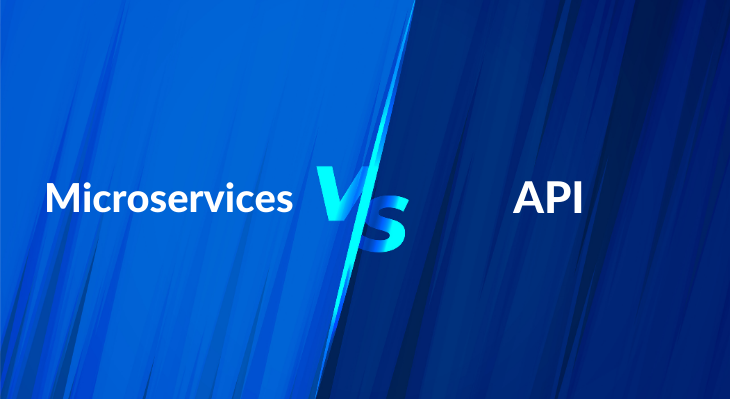Nowadays, software applications are built every single day in every corner of the planet. While making a software application, the developer must keep in mind many things. Right from code maintainability to user-interface. For this reason, there was a rise in microservices-based applications.
Microservices and API are distinct yet correlated to each other. Both Microservices and API involve the concept of architecture and interconnections. Where Microservices is the architecture, the API is the interconnections or gateway to a variety of services.
Often, microservices is considered a terminal point for the API, and that API is merely a part of a microservices. But the two are very distinct and they both serve different purposes.
In this blog, we’ll delve deeper into the mega question, “what is the difference between Microservices and API”. We’ll also take a look at their features.
Microservices vs. API: Difference Across Parameters
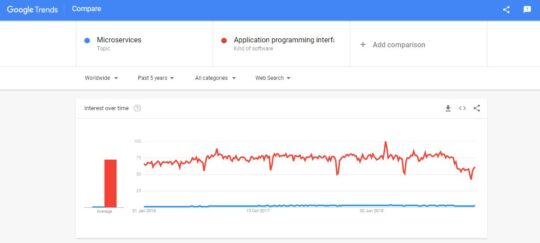
As we can see from the above image, API trails way ahead of Microservices in terms of popularity.
From the Google Trends image above, it is clear that few know about Microservices. It is a relatively new approach, which has been taken on by tech giants like Spotify, Netflix, Etsy, and more.
In short, Microservices is also known as Microservices Architecture, mainly because it is not an actual physical thing. It is a structure or a layout of how the developers divide the services of an application.
The services are loosely-coupled and fine-grained, hence the name “Micro” service. Microservices are the building blocks of what’s known as microservices-based applications.
From the e-commerce services diagram below, we can see that the services of an e-commerce application are divided into:
- Customer Business Logic
- Billing Business Logic
- Even Business Logic
The word logic itself is Microservices and all its functionalities, from data access layers to the database. This is a simple diagram where there are three microservices.
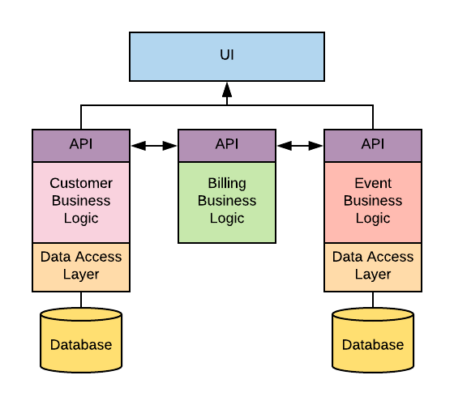
Figure: Microservices Architecture
Nowadays, all major software applications, whether Amazon or Netflix, use microservices architecture. They are a few of many microservices examples. The image below is the extension of the three microservices architecture above. Each node in the diagram denotes one microservices and how they are interconnected with the help of an API.

Figure: Amazon and Netflix Microservices Nodes
Monoliths are the predecessor of Microservices. They are the architectural style that involves all the services to be combined in one large block. Each service together would have only one Data Acces Layer and Database.
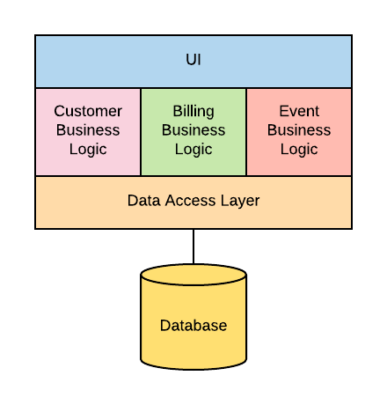
Figure: Monolith Architecture
Monoliths’ problem was that there were too many services and each had one binary file. This made debugging and problem-solving a hassle, apart from being large and bulky, taking a lot of disk space.
Microservices was created as the result of these problems with monoliths. It provided a solution for building distributed and cloud-based software applications. The services were divided into the business functions it handled.
Coming to Nanoservices, which is still unknown to many, is a new way of distributing and dividing the services even further. With each sub-service having its API end-point for faster results.
Also Discover: MVC vs. Microservices: Understanding their Architecture
Application Programming Interface, a.k.a API, is a gateway for the communications between 2 or more different services. API can be defined as tools, communication protocols, or methods between 2 or more components of the application.
For instance, you want to create a weather app, but you do not own weather forecasting equipment, reporting tools, or even maps. There is a Weather Department, ready to share the results from its Databases.
So, you use the Weather forecasting API, which acts as a plug. It takes all the weather forecasts from the database and transfers them into your weather app. This is an example of API and how it is used.
Companies like Instagram, Twitter, or Facebook want to make their components available. So these components and databases can be integrated with other third-party applications.
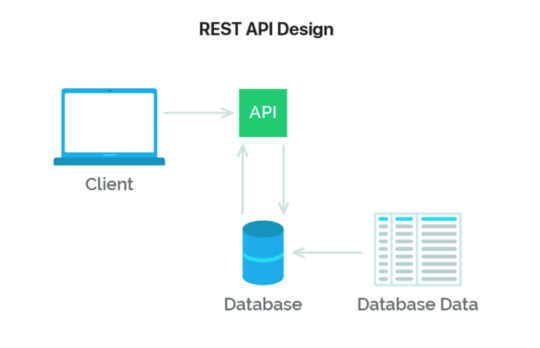
Figure: API Architecture
RESTful style APIs are the common API types. Four simple English verbs translate to API actions:
- GET: Get a single object or a collection from the database.
- POST: add an item to a group to the client.
- PUT: Edit an object that already exists in the database/client.
- DELETE: delete an object in a collection in the database.
Apart from the REST style, there are other types of APIs:
- SOAP
- RPC
- GraphQL
Let’s discuss the microservices example. We will be taking Uber as the use-case example. Uber when first launched, became instantly popular. To cope with the customer demands yet stay efficient in the software space they needed a new architecture, Microservices.
Initially, they were built upon Monolith structure. But to overcome growth hurdles they switched to cloud-based Microservices.
This led Uber’s software developers to build separate, individual services. E.g. maps, trip management, billing management, driver management and so on. Each had its own API.
With microservice style architecture, Uber achieved many advantages such as:
- It became more fault-tolerant. It had the ability to update without disrupting other services.
- Clear responsibilities and ownership to development teams of each service. This boosted the speed, security, manageability of the software application.
- Paved the way for Agile development and scalability.
Here are the main differences between microservices and APIs:
- Microservices is an architectural design that distributes services into containers with its database.
- API is a communication protocol or tool that helps integrate services or with 3rd party applications.
When it comes to API vs Microservices, API is indeed a part of Microservices and the microservices architecture is incomplete without an API. Here are some of the ways that microservices is integrated with API:
- To deliver CRUD operations(through API) to the applications with specific services such as customer, shopping cart, billing, etc. With e-commerce application being a microservice API example.
- To get data from databases for each service or component in the software application.
- To provide a ground to perform multiple actions with set parameters. E.g., microservices can provide the billing details(total price, items in the shopping cart, etc.), without the customer logging into the application.
Microservices is the software application building blocks. And the API is the glue that binds all the microservices together. When microservices architecture and APIs are used together to build applications. This results in many advantages such as:
- Both can provide scalability. The software application will grow, and services will be added or distributed according to their needs. The API will replicate on top of each service.
- Agile and cost-saving software development is achieved. Faster development of functions and modules.
- Security compliance is achieved as services are distributed. If one service is compromised, then other services can be saved and protected in time. Also, there are strict rules of data sharing in APIs.
- Microservices are built and run on distributed cloud-based services. This gives extra benefits to other cloud-based applications.
Conclusion
We have explained the comparison between Microservices and API. Core software development principles include developing modular, code maintainability, non-redundant, user-friendly applications.
One can achieve this by integrating microservices with API style architect model. Both are meant to meet specific requirements and are easy to use for developers, whether used separately or together.
You may also like to read: SOA vs. Microservices: Know the Architectural Evolution

